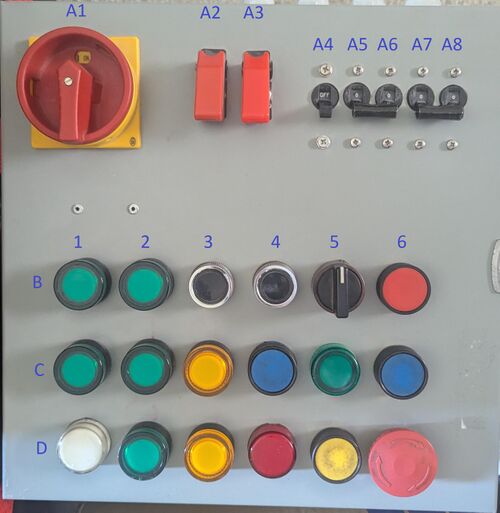Industrial Fidget Controller: Difference between revisions
Jump to navigation
Jump to search
(Started page) |
(Partial commit) |
||
| Line 1: | Line 1: | ||
=What is the Industrial Fidget Controller?= | |||
* The industrial fidget controller (IFC) was originally conceived as a joke (fidget spinners were a [https://en.wikipedia.org/wiki/Fidget_spinner#Popularity_and_usage fad in 2017] at Hacklab 2.0, but was crowdfunded by members to become a reality. | |||
* The intent was design an industrial control panel with an assortment of 22mm industrial buttons, indicators, and other tactile elements as a fidget toy for visitors. | |||
==Do-Ocracy Policy== | |||
==TODO List== | |||
** TODO: Install second keystation in workshop. | |||
** TODO: Spin up ESP+IR Blaster device to control shop air cleaner. | |||
=Documentation= | |||
==Hardware Overview== | |||
* The IFC uses an Automation Direct Click PLC | |||
==Functionality== | |||
* Each switch on the front panel, as well as remote devices (through connectors J1 thru J4) are exposed to Home Assistant using a MODBUS TCP integration to poll the PLC at a 5 second interval. | |||
** Note: polling frequency is limited by Home Assistant due to stability issues with the MODBUS TCP plugin. The PLC can support a much higher polling frequency. | |||
* Certain button or switch combinations can create light animations as a reward for fidgeting. More Easter eggs may be added as time progresses. | |||
* Inside the enclosure an electro-mechanical counter keeps track of the total number of button pushes this installation serves to satisfied customers. If you are quiet, the electro-mechanical counter can be audibly heard. | |||
* There are 2x remote keystations, each featuring a key-switch, a toggle switch, and a future LED back-light for the switch. | |||
==Button Mapping== | |||
* Entities are exposed to Home Assistant based on the switch contact or LED indicator corresponding to the location below. | |||
* All entities are prefaced with '''IFC_*''' where * is the device address (eg: A1, B2, etc). | |||
* Push buttons B1, B2, C1, C2, C3, D2, D3 have been configured as latching switches and can be used to enable or disable specific Home Assistant output devices (eg: a disco ball). | |||
* Circuit breakers A1 + A4-A8 are configured like any other input device to the PLC and do not involve any mains AC voltage (the entire front-panel is powered by +24VDC and is grounded for safety regardless). | |||
[[File:Fidget_Controller_Panel_Mapping.jpg|500px]] | |||
==Expansion Connectors== | |||
* Note: J1-J4 are NOT hot-pluggable. Please power down the unit before disconnecting these. | |||
Revision as of 14:04, 16 May 2025
What is the Industrial Fidget Controller?
- The industrial fidget controller (IFC) was originally conceived as a joke (fidget spinners were a fad in 2017 at Hacklab 2.0, but was crowdfunded by members to become a reality.
- The intent was design an industrial control panel with an assortment of 22mm industrial buttons, indicators, and other tactile elements as a fidget toy for visitors.
Do-Ocracy Policy
TODO List
- TODO: Install second keystation in workshop.
- TODO: Spin up ESP+IR Blaster device to control shop air cleaner.
Documentation
Hardware Overview
- The IFC uses an Automation Direct Click PLC
Functionality
- Each switch on the front panel, as well as remote devices (through connectors J1 thru J4) are exposed to Home Assistant using a MODBUS TCP integration to poll the PLC at a 5 second interval.
- Note: polling frequency is limited by Home Assistant due to stability issues with the MODBUS TCP plugin. The PLC can support a much higher polling frequency.
- Certain button or switch combinations can create light animations as a reward for fidgeting. More Easter eggs may be added as time progresses.
- Inside the enclosure an electro-mechanical counter keeps track of the total number of button pushes this installation serves to satisfied customers. If you are quiet, the electro-mechanical counter can be audibly heard.
- There are 2x remote keystations, each featuring a key-switch, a toggle switch, and a future LED back-light for the switch.
Button Mapping
- Entities are exposed to Home Assistant based on the switch contact or LED indicator corresponding to the location below.
- All entities are prefaced with IFC_* where * is the device address (eg: A1, B2, etc).
- Push buttons B1, B2, C1, C2, C3, D2, D3 have been configured as latching switches and can be used to enable or disable specific Home Assistant output devices (eg: a disco ball).
- Circuit breakers A1 + A4-A8 are configured like any other input device to the PLC and do not involve any mains AC voltage (the entire front-panel is powered by +24VDC and is grounded for safety regardless).
Expansion Connectors
- Note: J1-J4 are NOT hot-pluggable. Please power down the unit before disconnecting these.
